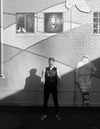A little piece of shade

Tomorrow is the one year anniversary of the mass shooting in Uvalde, Texas. You remember that one. It was one of the ones that was bad enough that we'll always remember it. Meanwhile there have been 236 mass shootings (in which four or more people are injured or killed) this year according to the Gun Violence Archive. That's over a span of just 143 days. Over that period there have been 16,640 gun deaths.
I don't really know what my point is here. Or if there's a point of saying anything about it at all.
Tonight on @wbaltv11: A man with an AR-15 has been showing up for weeks to a school bus drop off for local elementary school students.
— Tolly Taylor (@TollyTaylor) May 18, 2023
Parents say their kids are afraid, the man says he’s protesting @GovWesMoore’s new gun control law. You’ll hear from both sides at 5+6pm. pic.twitter.com/rpdJXAkVh4
Him? Oh that's just the School Bus Stop Machine Gun Man. No we can't make him leave because of James Madison. He's pretty harmless aside from holding a machine gun.
— luke (@lukeoneil47) May 19, 2023
The second part of my interview at The Small Bow was posted the other day. I mostly talked about my drinking and eating issues.
I don’t want to die young by the way. “Young” I suppose. I don’t want to die at all. Being dead seems like it fucking sucks. Among the worst deals we have going. But I don’t particularly care about any of the associated issues with drinking too much besides the weight gain at this time. Everything else that comes with it is none of my business.
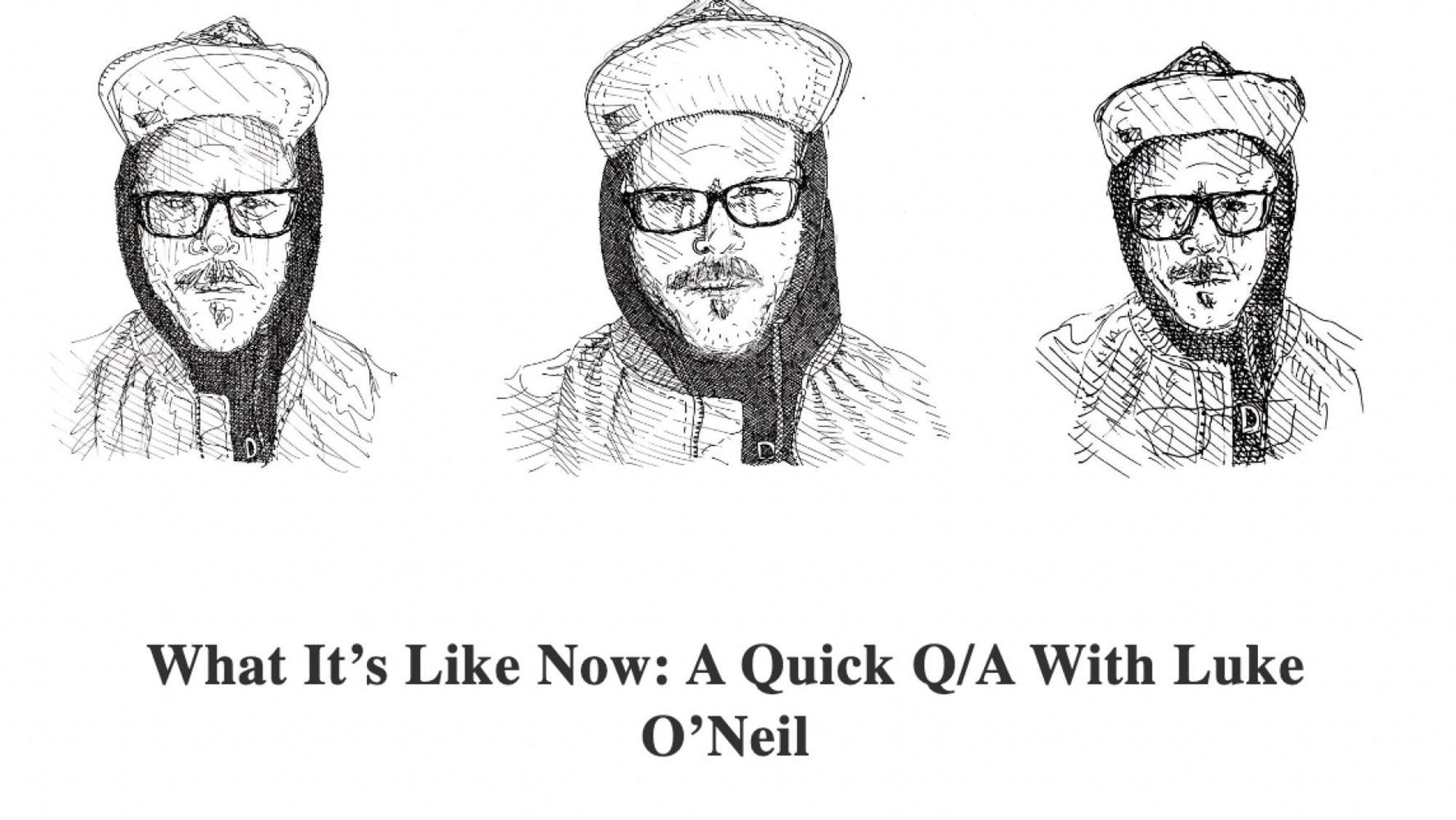
I also did a lengthy interview about A Creature Wanting Form with The Underline newsletter. We talked Virginia Woolf and Norm Macdonald and George Saunders and Donald Barthelme and my whole deal &c.
DS: Woolf is such a master of rendering stream of consciousness and her characters’ inner lives. I thought you did a great job in this book of twisting that into rendering distraction. I wondered if you had any thoughts about that distinction, if that was something you were trying to accomplish.
LO: It's been years since I read her extensively—I basically gorged myself on Virginia Woolf in college and grad school, but I’m by no means a scholar of hers anymore. But if, by distraction, you mean like all the characters in the book are never fully present in where they are and they're often looking at their phone?
DS: Yes, exactly.
LO: That is a device that does a couple of different things. Obviously, first of all, most people are constantly looking at their phone now, but I've never really seen anyone accurately capture that aspect of how it is to live now. Because you can just be there having the most meaningful, poignant, or distressing experience that’s happened in your life, and you're going to look at your phone anyway. That's a part of life that doesn't necessarily get captured as much in fiction. They try in TV and movies now, they do a little bit better job of showing people texting and stuff.
The other thing that device does is it provides you a window to the world in a way, if that doesn't sound weird. In the context of a story, it would be weird if some guy was just at the beach and all of a sudden you just started talking about some shooting going on somewhere or something, a storm happening in a different state. But being able to say, “He looked at his phone and there was a shooting going on.” That brings the entire world to the small setting of the story in a way that I thought felt natural to how our brains work now.
In a straight-up poem, you can kind of jump all over the world. But in a short story, you want it to be a little more point A to B. Or there's some scenes where the guy’s glancing at the TV, I guess that's an older type of trick to do it. Here's something thematically resonant that's happening elsewhere that kind of colors the mood and the tone and the themes of what's happening to this person.
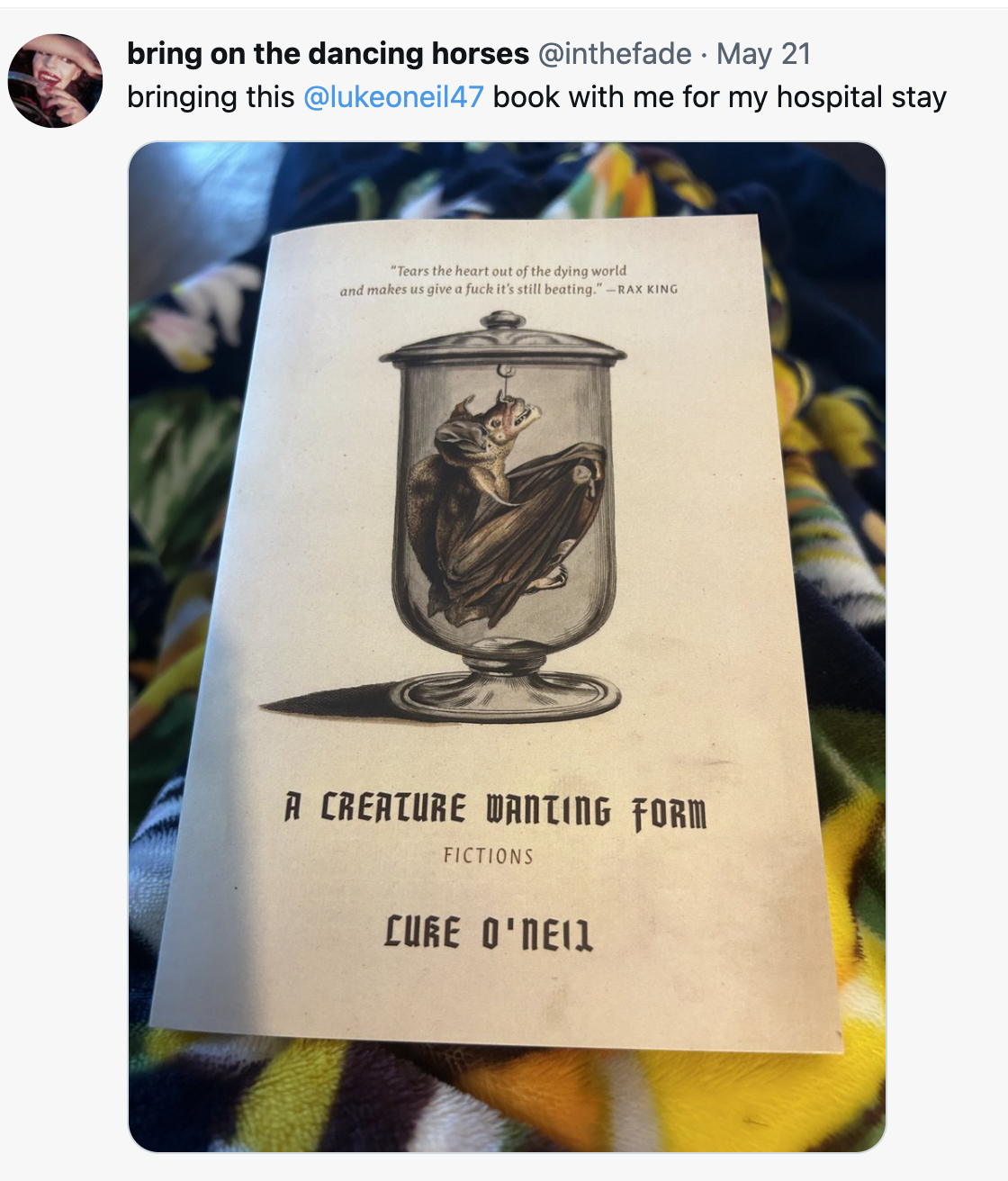
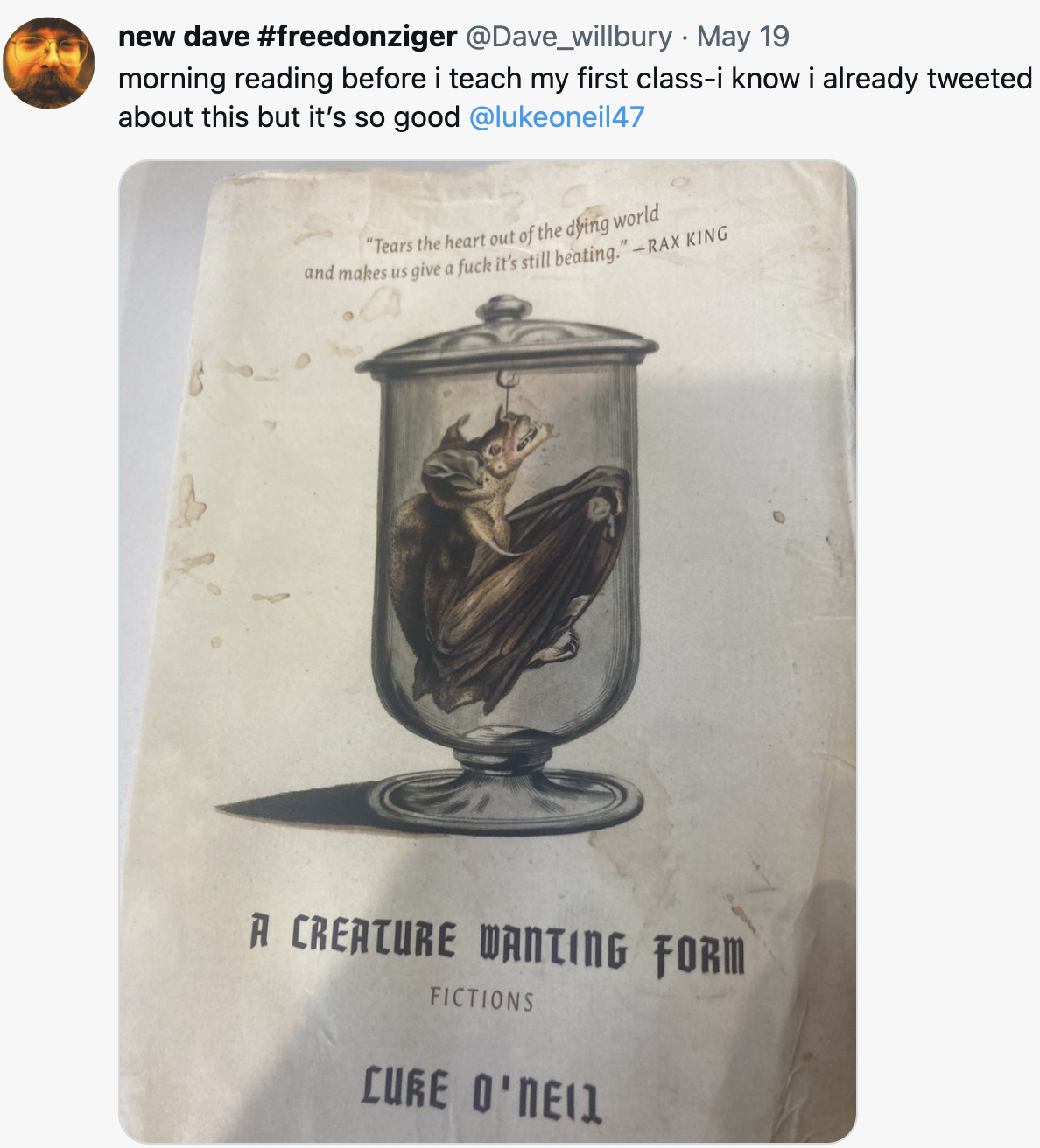
Here's another short one from my book:
October 27, 2004
Across the street some kids were playing baseball which felt anachronistic in the first place and one of them socked a big dinger and they all moved instinctively and anxiously like they do when that sort of thing happens. I watched the ball arc up toward the moon which wasn’t out yet but you could tell was waiting there just backstage rehearsing its lines and I thought people that young are walking on a tightrope they aren’t even aware of yet. Not just unafraid of falling but oblivious to the existence of the chasm.
I was listening to In the Aeroplane Over the Sea I’m sorry I know and I thought that if you skip “[untitled]” you didn’t earn “Two-Headed Boy Pt. 2” because in my day we suffered differently about things that didn’t matter.
I never knew if it was meant to be I love you comma Jesus Christ or if it was supposed to be I love you Jesus Christ straight through no punctuation like was he addressing some person or the Son of God himself.
Jesus Christ I love you yes I do.
On my phone there was a grim dark storm cloud hovering over Rhode Island and the blackness looked like it had one little arm or flipper hanging down to do its damage with like a perverted little sky imp would have and there were two bright orange lights right in the center where the storm’s face would be if storms had faces.
I think it was just the reflection of some tower lights though.
Next door the neighbor’s dog was barking so sadly in a language I couldn’t understand. Like when you’re in another country and you need to find the hospital immediately or find your kidnapped wife and no one knows what you’re trying to say.
It’s good to be in those situations. Not the needing a hospital or having a kidnapped wife obviously but to be somewhere where you can’t communicate.
To feel stupid and helpless like that from time to time.
To be elsewhere.
It was the anniversary of the first time the Red Sox had won the World Series after eighty-six years and people were remembering it all over the place. Someone on my phone had asked people to chime in with what they were doing that night and one guy said he remembered watching it at a friend’s house and then calling his dear old nana who had loved the team her entire long life and had never gotten to see them win before then and she cried and her crying made him cry.
The funniest part the guy said was driving home after the game and seeing someone hopping a cemetery fence with a bottle of champagne.
Some kid thwacked a double and you could hear it so loud and clean. I almost spilled my drink. Some guy’s kid and he’s running around the bases now. Look at him running so fast away from God and the Devil and from everybody knowing instinctively where each foot needs to land without even thinking.
You may have heard about an exciting innovation in shade technology unveiled last week by the Los Angeles Department of Transportation. Now for most of us on a typical day – unless you live in the city and avail yourself of its public transport – we don't tend to hear much about such matters. But the much ballyhooed La Sombrita bus stop shade installation is so useless and expensive and symbolic of municipal bureaucratic dysfunction that it was immediately and roundly mocked all over social media. It's also somehow supposed to have something to do with gender issues? The city seemed very proud of it!
"The yawning chasm between the city’s triumphal tone and the minuscule achievement it unveiled was simply too great," Slate wrote. "L.A. was achieving equity with … this? The outrage grew when it came out that the prototype cost around $10,000. Couldn’t that have been spent on a roof over a bench? Or a new well to plant, water, and care for a shade tree—even two? “Performative grift,” someone sneered. “An episode of Veep … set at a transit agency.” Here was another hapless city government, strangled by its own bureaucracy and regulations, taken for a ride by a bunch of consultants masquerading under the banner of diversity, equity, and inclusion."
"Which is why La Sombrita is a sign of so much more than how LA lets down its bus riders," Vice noted. "It is something even non-bus-riders and non-Angelenos should see as a symbol of our failures. It is about American cities erecting vast, complex bureaucracies with insanely complicated rules and norms that make it difficult to build literally anything. As Curbed mentioned back in 2021, getting a bus shelter installed in Los Angeles is a 16-step bureaucratic minefield involving at least eight city departments and the approval of elected officials. All to build one bus shelter!"
It was in other words a whole fucking thing. I asked our Los Angeles correspondent Andreina Kniss to write about what is going on over there.
Previously Kniss wrote for Hell World about the idea of putting unhoused people into (kinder and gentler) concentration camps.
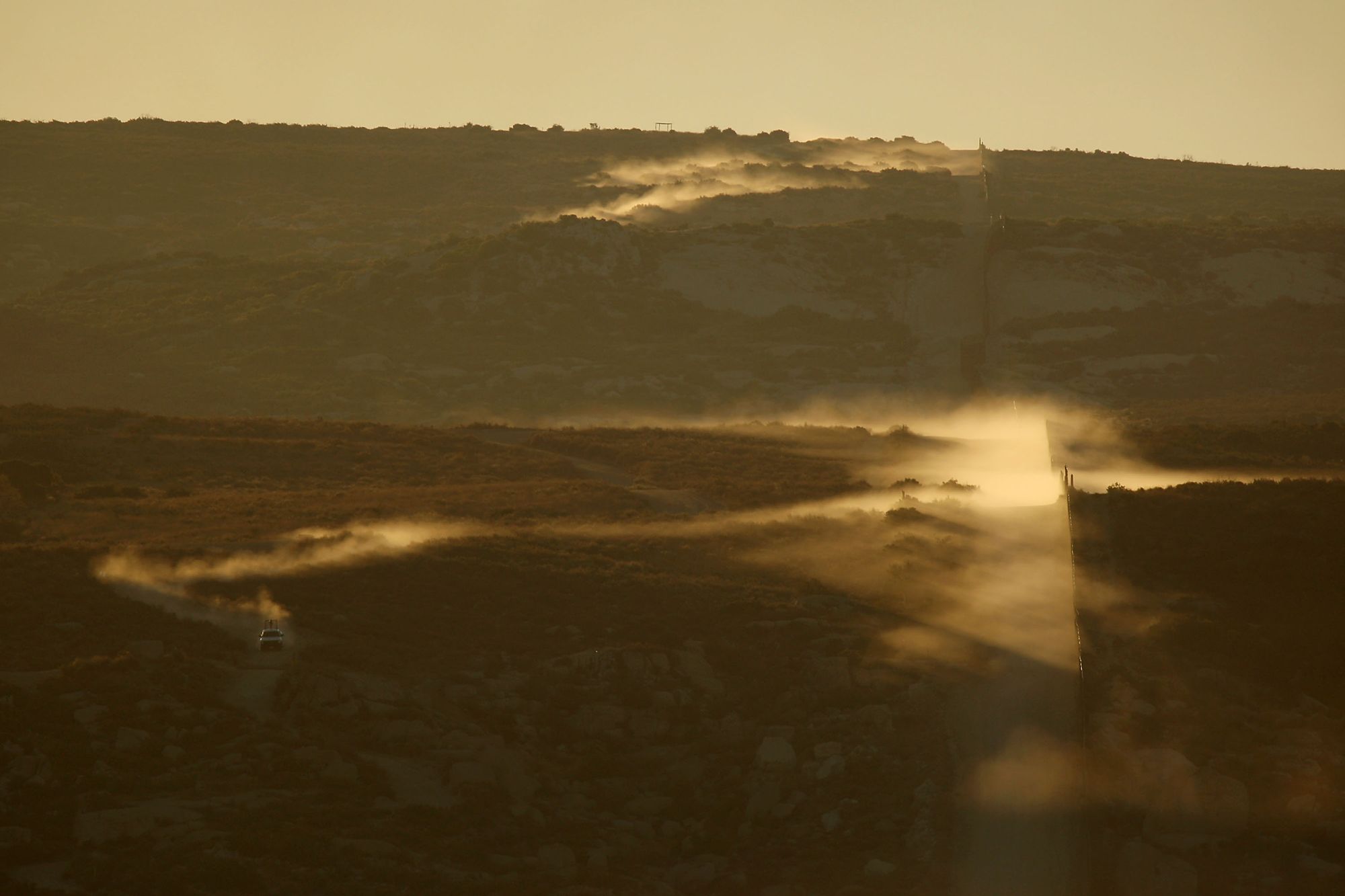
Before that we spoke about their aid work and outreach for the unhoused in Los Angeles.
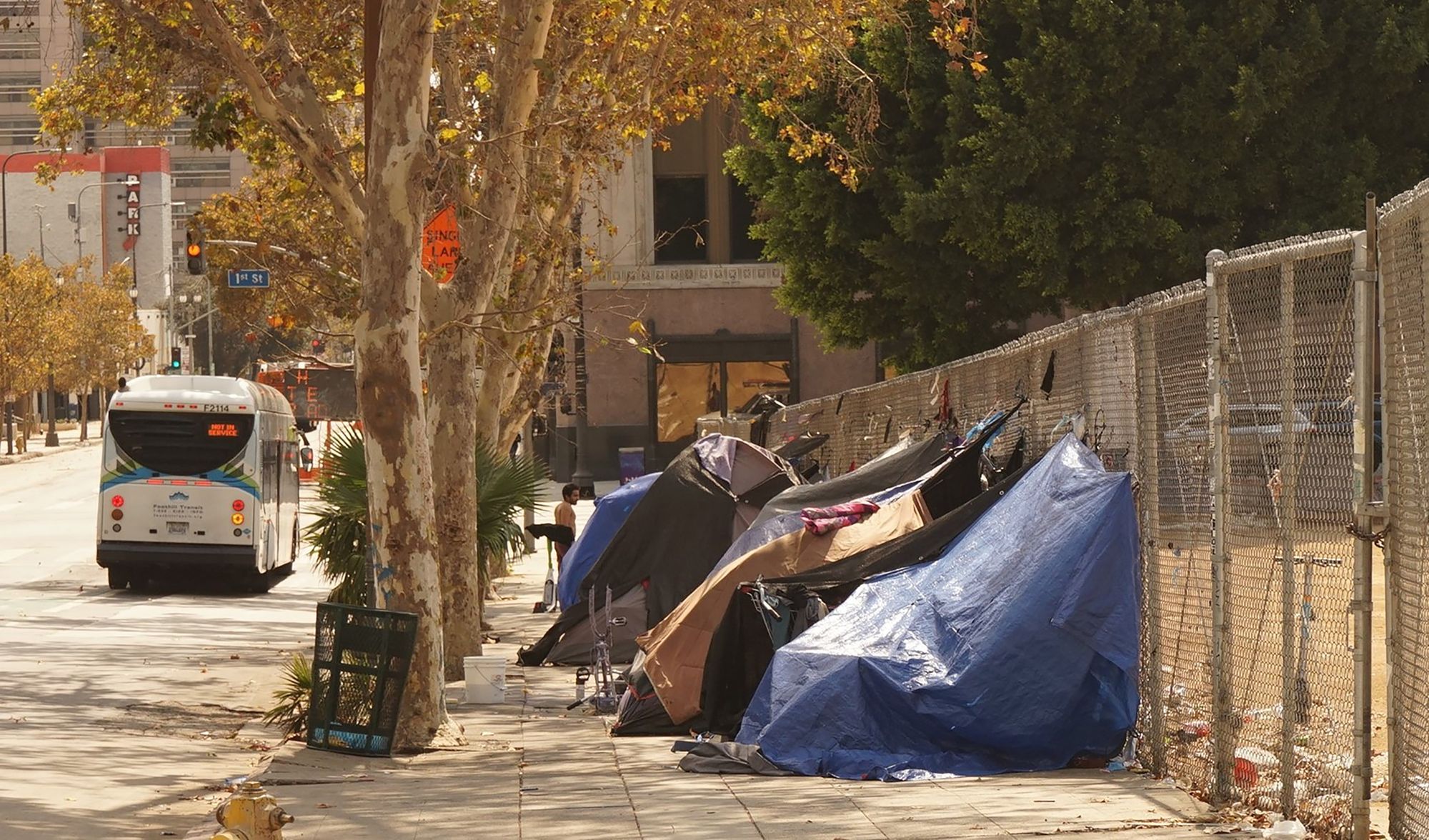
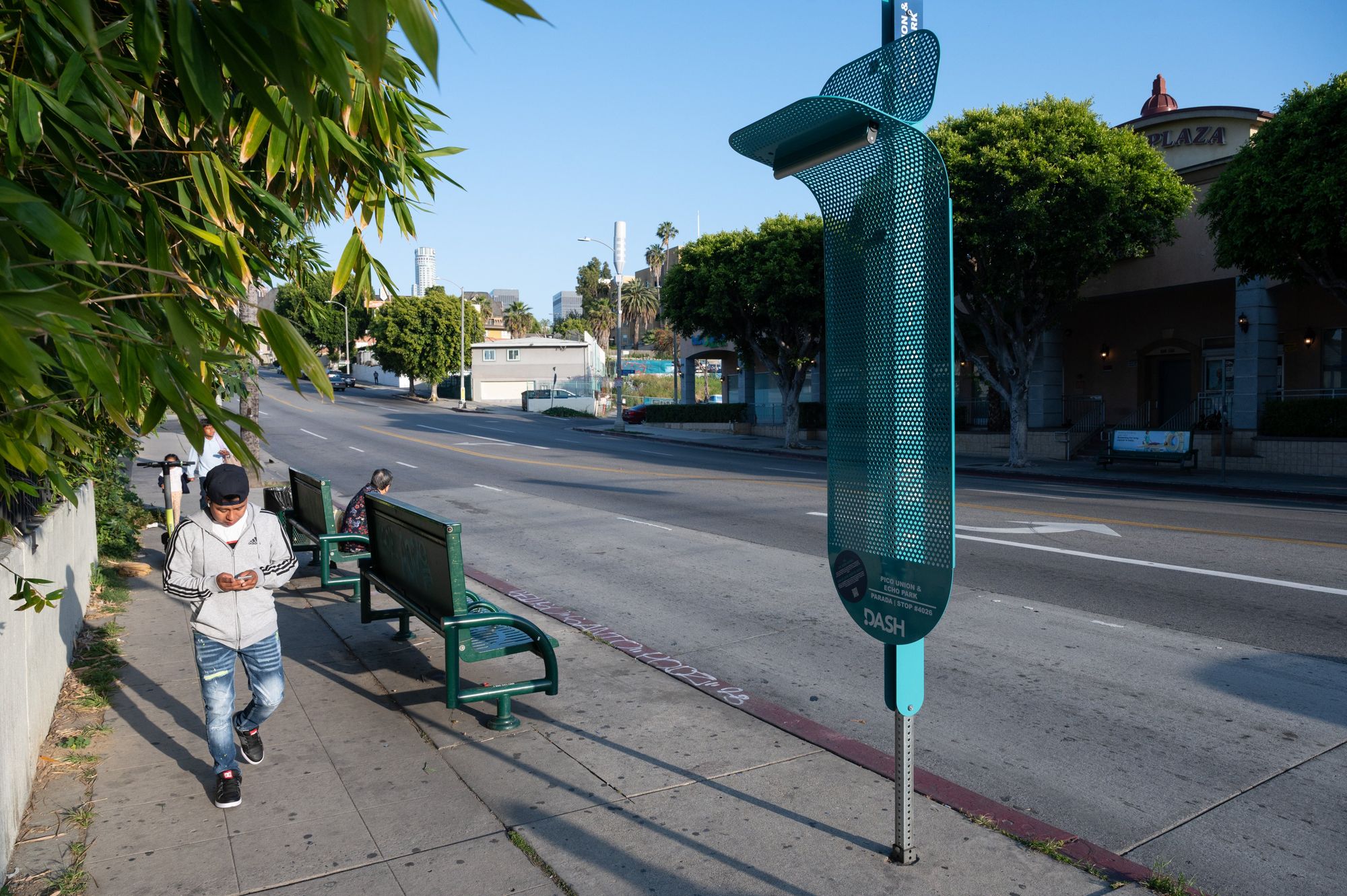
Pretending to Care is Expensive
by Andreina Kniss
Last year Los Angeles had one of its worst heat waves on record. Those that could retreated into their air conditioned homes, shops, and cars, and those that couldn’t simply and unceremoniously cooked. The four to five families living in a one bedroom apartment, the over 40,000 unhoused people living outside on the street, and the commuters using the bus and trains to get around suffered immensely. Some died. Any poor person in Los Angeles can tell you a hundred different ways that the city is failing its residents. As climate and economic conditions worsen, there is a more urgent demand that the city do something to address these issues. Do something – anything – to make things better.
The Los Angeles city government has taken on this new demanding constituency largely by privatizing public resources, making life impossible for the unhoused, and giving large contracts to non-profits of varying efficacy. They have been pressured and guilted into pretending to care about the issues plaguing our city, while at the same time doing their best to protect the status quo and the people with money who really run Los Angeles.
Everyone in power now has to claim to want to end homelessness, but all of them bend the knee to developers and landlords who are filing record numbers of evictions as we speak. The Los Angeles Homeless Services Authority press releases celebrate how many people they successfully housed every year. Last year they housed 20,000 plus people. That sounds like, and is in fact, a lot of people, but it doesn’t touch the amount of new people that get evicted and become unhoused every day. That growing number far outpaces the amount of shelters we could ever build and people we can house under our current programs. Every politician supports building housing to address the “housing shortage,” but only luxury housing, of course. Apartment buildings that charge a $10,000 deposit to move in and $3,000 a month to maintain a tenancy in are popping up everywhere, yet the number of people on the streets and the price of rent continues to rise.
It’s a dance and a performance, and one that comes at a high price.
Ride Cool!🚏 Today, with @cd1losangeles, we unveiled "La Sombrita" at Union & 3rd! This new design pilot tests a low-cost infrastructure that can be quickly installed to improve the transit experience for those who rely on public transit with better lighting and shade. pic.twitter.com/NCJjXQ2372
— LADOT (@LADOTofficial) May 18, 2023
The most recent of the city’s half measures that was announced via press conference this week is known as La Sombrita. There was a lot of fanfare about a bus stop shade structure that provides no seating, very little shade, and that is topped with a tiny solar powered light bulb all for a price tag of $10,000 each. Its launch caused a ripple of confusion, ridicule, and fury throughout Los Angeles. La Sombrita is meant to address the fact that only 26% of Los Angeles bus stops have some sort of shade. Most bus riders have to seek shelter under trees, store awnings, or just suffer in the heat under the scorching sun. La Sombrita’s see-through grate measures at about three feet in width, and would provide enough shade for a single person who leans against it at a very specific time of day.
The design firm behind it and The Los Angeles Department of Transportation also confusingly lauded La Sombrita as a win for gender equality because women (who are the most frequent public transit users in LA) should theoretically feel safer with the tiny lightbulb it has on top of it while they wait for their bus at night.
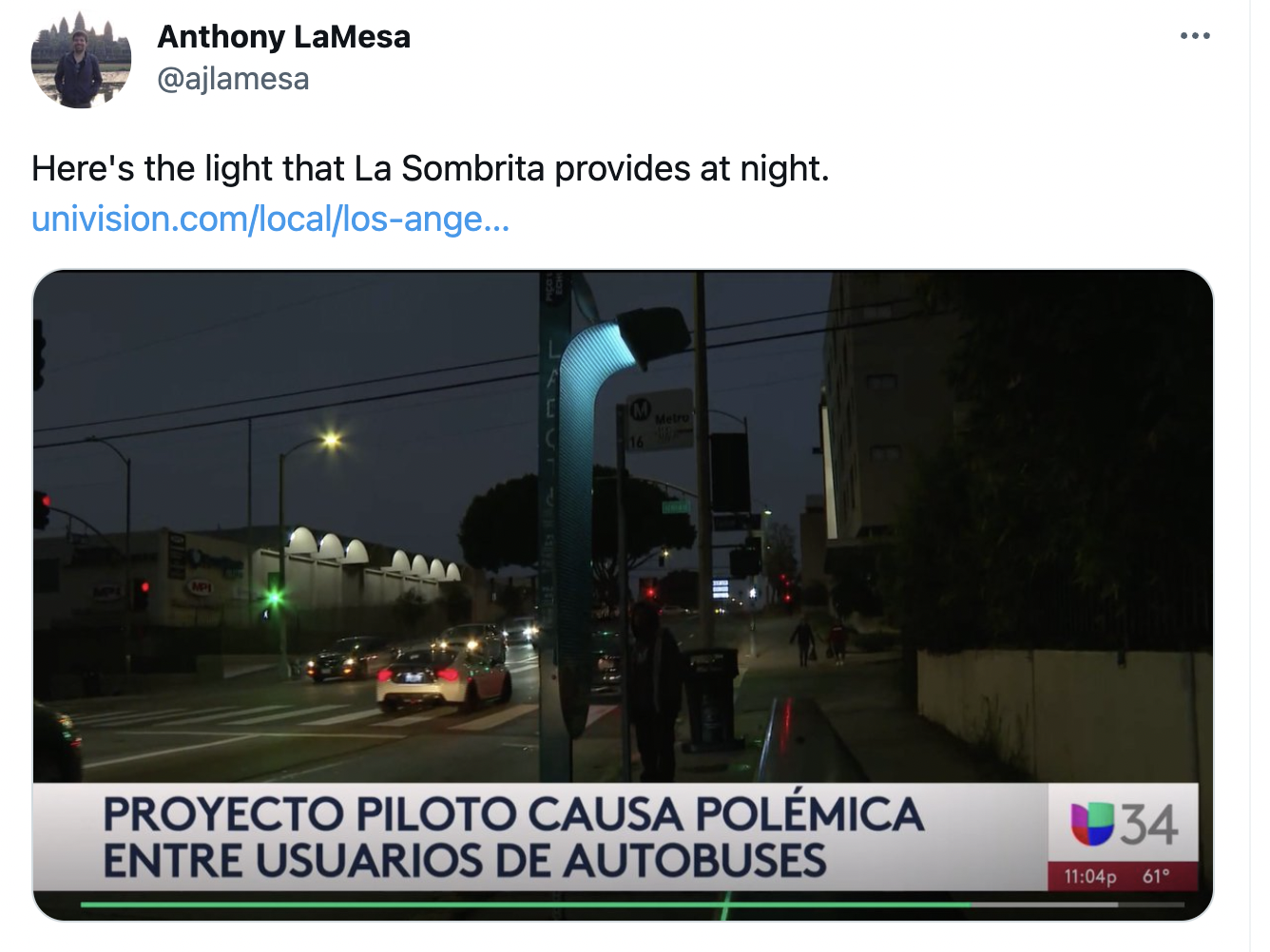
They said that the cost of installing one of the La Sombrita designs was only $10,000 vs. the $50,000 it costs to install a large traditional shade structure over a bus bench. They also highlighted that it was able to be installed really quickly because it only needed LADOT approval while traditional more effective shaded structures go through eight different departments for approval.
After a wave of justified criticism, the design firm turned off comments on Twitter and defended their launch. They said La Sombrita was designed with input from women who ride the bus regularly while simultaneously fitting within the narrow parameters given to them by the city of Los Angeles. But therein lies the issue. Why are the parameters like this? Why does it take eight different departments to approve a real-deal functional shade structure? Why are city sidewalks designed to be too narrow to accommodate full size shade structures in the first place? Why can’t bus systems be staffed and funded so they drive by every five minutes instead of every 45 minutes, so people (and women in particular) don’t have to sit there for long before they get on? Why is it a matter of celebration to produce something expensive, useless, and barely functional, just because it fits within these slim parameters instead of actually producing something the community truly needs?
In a similar vein of band-aid solutions, LA taxpayers are paying about $2600 per tent per month to run a safe camping site where unhoused people are processed and assigned a concrete square where they can place a tent in. There are security guards and fencing, sure, which is an improvement from the danger of the unmonitored streets outside. But a very reasonable question one might ask after hearing about these camping sites is “Why can’t we just use that money to pay people’s rent since the average room in LA rents for $2700?”
The answer comes down to city leadership with no interest in challenging the economic system that allows for this spending and human suffering, a non-profit industry dependent on government contracts, a drive to make it look like they’re helping, and zero fear of a pissed-off public. As long as the poor are patronized, punished, and looked down upon in favor of capital, those in the seats of power in large cities are not going to take their needs into account when designing the future of these cities.
San Francisco had a similar "La Sombrita" moment occur when they announced the designs of new trash cans that struggled to hold trash and cost taxpayers a whopping $20,000 each to develop. The reason for the hefty trash can pricing and limited trash capacity was because the city wanted it to be particularly resistant to human scavenging. Again, we could ask “Why don’t we make society better so people don’t have to scavenge through the trash to sustain themselves instead of paying half a million dollars to develop these impenetrable trash cans?” But San Francisco leadership doesn’t think that far ahead. Our whole society doesn’t.
We’re going from band-aid to band-aid and it’s costing us lives, money, and the health of our society. We’re ending up with ridiculous, overpriced items like trash cans that people can’t put trash in because they might be helpful to the unhoused, La Sombritas that don’t provide any significant shade, and safe camping sites that don’t house people. We don’t have benches in our parks or sidewalks, public bathrooms, or drinking fountains for these same reasons. Our city planners and those in power are very enthusiastic about chipping away at the fabric of our cities and making things hostile to all human life as long as the poor don’t get any comfort or support as well. Because they know the rich will always be able to buy comfort. They work on making their backyards their parks, they go to private pools at country clubs, and in emergencies they don’t think twice about buying an item so they can use a customer-only bathroom.
The solutions to the issues these band-aids are trying to address would be healthy public housing, social welfare infrastructure, car-free cities with ample public transit, green spaces, universal healthcare, food programs, sports and afterschool programs, usable public fixtures, and free higher education. But then we wouldn’t need the non-profit industrial complex and we might make billionaires who leech off the poor slightly less rich. Our electeds have decided that’s an unacceptable result. Our current world where over 40,000 people sleep outside and we get La Sombritas at a handful of bus stops while people continue to suffer in the heat is the accepted result. We're in a very dark place right now and it's not because of the shade.
Andreina Kniss is an organizer at KtownForAll, an all volunteer unhoused rights and outreach organization that supports and advocates for the unhoused community in the Koreatown Los Angeles neighborhood.
I was thinking about Norm Macdonald since I talked about him as an influence in the interview above and then I saw this series of posts he made about being interviewed about his own book compiled here on Twitter that I found fascinating and very beautifully said.
I did not understand that when I wrote a book I would have to go on TV shows and talk to newspapermen, in order to shill it. And so I did many interviews in New York last week and will in LA this week.
The book is true but all the questions I received were about facts. I found it very funny because in the very first chapter of the book I told why I had written the book. I wrote the book because I read my Wikipedia entry and it was a series of facts and I feel a man's life is more than that. It must be. And so I endeavored to write the truth of my life, and not the facts of my life. And now I am doing interviews with people and they all ask me about facts, the very things I find insignificant.
But one must be polite after all and answer questions that are asked of you. Only Howard Stern understood to push through the facts to the truth that were their foundation. I found during the hundreds of interviews, that the vast majority of journalists are in love with lies.
Many times a journalist would ask me to comment on something that had happened in my life. Problem was it had never happened. And so I would tell the chap this. That it had never happened. And then the chap would go away and write the lie anyway, and give the lie more power. And I became despondent, since the interviewer had no use for me as he was both asking and answering his questions.
I wrote the book Based on a True Story:A Memoir so my life would be wrote and I put all there was in the book. But I also wrote the book to make people laugh, which is the thing in my life that brings me joy. Often, when people interviewed me, I would answer with a funny remark, and the journalist would laugh, and then not include it. Even worse, I would make up a premise in order to make the punchline funny and they would excise the punchline, leaving only a lie. I'm rambling, something people accuse me of more and more as I grow old and fat, as if it was a bad thing to do.
I understand this voracious desire for facts, for stories behind the story of show business, for what is called "backstage." The problem with "backstage" is that it is so less interesting than "Stage." All that is done backstage is creating stage. But there is a different sort of backstage. The backstage of your life. The truth behind the facts.
I once knew a boy named Michael. I was very young and he was my hero. A hellion, my Dad called him. But Michael, who was eight years old knew something that no one else I knew knew. He knew that all the facts in the whole world was only empty gossip and so he made his own world.
By the time he was 14 or so, Michael had lost his mind and was put away, but he had a glorious 14 year run and I witnessed it. There is glory everywhere and we keep missing it because we are doing our chores. It's not our fault. Chores don't do themselves.
When I meet someone on a train, which I often am on, and we are both strangers, that is when I can get down to truth, ugly and beautiful. And he can too. All that is required is that there is motion (the train), anonymity, and a destination. Those are the times I have found out what Man is, from this man, still but moving fast, unafraid.
Strangers are wonderful. We don't watch our words. We don't care what they think of us. They cannot be hurt by us. We can tell them truth. And, so, most of my book, Based on a True Story, was written on a train. And what does it mean to be on a train. What does it mean to be on a train.
Love you. Good Night.
I thought this was a very good short short story.
My stupid fucking town elected a five-year-old boy for mayor as a "protest"...of course 2 years later we're still digging "to china". He thinks it's possible and we have to obey him. Not just legally but now 84% of the town is employed by The Hole. We have families pic.twitter.com/9b4MDa8gBk
— sean (@DilettanteryPod) May 20, 2023
Ok here's a poem and a song for the road. Goodbye.
The Double-Bed Dream Gallows
by Richard Brautigan
Driving through
hot brushy country
in the late autumn,
I saw a hawk
crucified on a
barbed-wire fence.
I guess as a kind
of advertisement
to other hawks,
saying from the pages
of a leading women’s
magazine,
“She’s beautiful,
but burn all the maps
to your body.
I’m not here
of my own choosing.”
